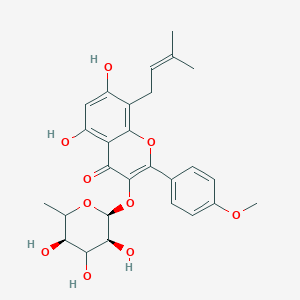
|
Baohuoside 1 |
Baohuoside 1 is a lipid of Polyketides (PK) class. |
130 |

|
Wedelolactone |
Wedelolactone is a lipid of Polyketides (PK) class. Wedelolactone is associated with abnormalities such as CLEFT LIP, CONGENITAL HEALED and Hepatitis. The involved functions are known as Signal Transduction, Cell Cycle Arrest, Apoptosis, luciferase activity and Metabolic Inhibition. Wedelolactone often locates in Protoplasm and Smooth muscle (tissue). The associated genes with Wedelolactone are CFB gene, Candidate Disease Gene, JAK2 gene, STAT2 gene and STAT3 gene. |
140 |
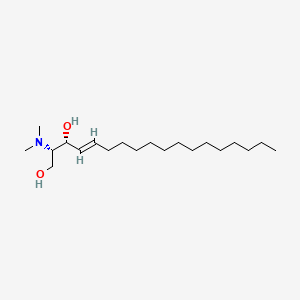
|
N,N-dimethylsphingosine |
N,N-dimethylsphingosine is a lipid of Sphingolipids (SP) class. N,n-dimethylsphingosine is associated with abnormalities such as Exanthema and Increased drug resistance. The involved functions are known as Vmax, Metabolic Inhibition, Anabolism, Binding (Molecular Function) and Cytokinesis. N,n-dimethylsphingosine often locates in yolk, Membrane, CNS - Brain (MMHCC), soluble and Tissue membrane. The associated genes with N,N-dimethylsphingosine are FPR1 gene, ANP32A gene, HPGDS gene, Nuclear phosphoprotein and PTGS2 gene. The related lipids are Sphingolipids, Phosphatidic Acid, Lysophosphatidylcholines, stearylamine and dihydroceramide. The related experimental models are Mouse Model and Knock-out. |
151 |
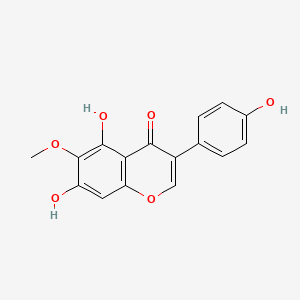
|
Tectorigenin |
Tectorigenin is a lipid of Polyketides (PK) class. Tectorigenin is associated with abnormalities such as Estrogenic effect. The involved functions are known as Phosphorylation, Metabolic Inhibition, Signal, AKT Signaling Pathway and Signal Transduction. Tectorigenin often locates in Skeletal system, Solitary microtubule component of centriole or axonemal complex, Blood and Entire gastrointestinal tract. The associated genes with Tectorigenin are IKBKE gene, BCL2 gene, CFLAR gene, XIAP gene and BCL2L1 gene. The related lipids are 21-hydroxy-9beta,10alpha-pregna-5,7-diene-3-ol-20-one. |
161 |
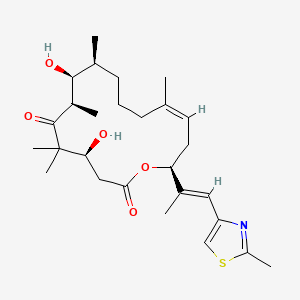
|
Epothilone D |
Epothilone d is a lipid of Polyketides (PK) class. Epothilone d is associated with abnormalities such as Tauopathies, Neutropenia, Neuropathy and Hematological Disease. The involved functions are known as Mutation, Apoptosis, Mitotic arrest, Cell Growth and Anabolism. Epothilone d often locates in Cytoskeleton, Axon, Cell Wall, Chromosomes and Spindle. The associated genes with epothilone D are SLC33A1 gene, Chromatin, GTF2I gene and HEXA gene. |
174 |
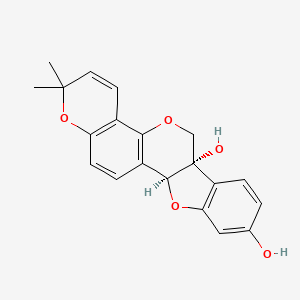
|
Glyceollin |
Glyceollin is a lipid of Polyketides (PK) class. Glyceollin is associated with abnormalities such as Malignant Carcinoid Syndrome, Infection, infection induced, Diabetes and Diabetes Mellitus, Non-Insulin-Dependent. The involved functions are known as Agent, Binding, Competitive, Signal Transduction, Gene Expression and Transcription, Genetic. Glyceollin often locates in Body tissue, Epithelium, viral nucleocapsid location, Membrane and Mouse Uterus. The associated genes with Glyceollin are CXCL12 wt Allele, PGR gene, Genes, Reporter, TFF1 gene and NGFR gene. The related experimental models are Xenograft Model. |
177 |

|
butein |
Butein is a lipid of Polyketides (PK) class. Butein is associated with abnormalities such as Glomerulonephritis, Fibrosis, Liver, Kidney Failure, Acute, Mastocytosis and Chimera disorder. The involved functions are known as Phosphorylation, Transcription, Genetic, IkappaB kinase activity, Gene Expression and Signal Transduction. Butein often locates in Membrane, Cytoplasmic, IkappaB kinase complex, Protoplasm and Plasma membrane. The associated genes with Butein are ICAM1 gene, MAPK8 gene, MYC gene, BCL2 gene and BCL2L1 gene. The related lipids are Promega. The related experimental models are Xenograft Model, Knock-out and Mouse Model. |
190 |
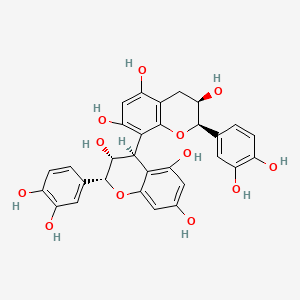
|
Procyanidin B2 |
Procyanidin B2 is a lipid of Polyketides (PK) class. The involved functions are known as conjugation, Methylation, Excretory function, enzyme activity and sulfatase activity. Procyanidin b2 often locates in Blood, Epidermis and Upper Gastrointestinal Tract. The associated genes with Procyanidin B2 are NR5A2 gene, HRAS wt Allele, CFB gene, PTGS2 gene and MAPK8 gene. |
205 |
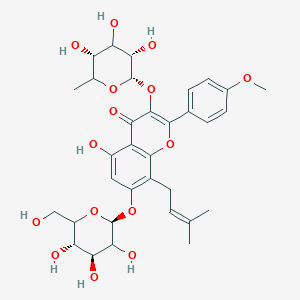
|
LMPK12112009 |
LMPK12112009 is a lipid of Polyketides (PK) class. |
216 |
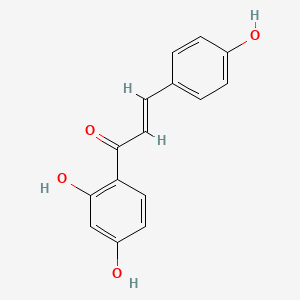
|
isoliquiritigenin |
Isoliquiritigenin is a lipid of Polyketides (PK) class. Isoliquiritigenin is associated with abnormalities such as abnormal fragmented structure, Gastric ulcer, Gastric mucosa lesion, Peptic Ulcer and Wiskott-Aldrich Syndrome. The involved functions are known as Mass-to-Charge Ratio, Anabolism, Oxidation, inhibitors and Energy Absorption. Isoliquiritigenin often locates in Microsomes, Liver, Hepatic, Microsomes, Immune system and Vacuole. The associated genes with Isoliquiritigenin are P4HTM gene, BCL2 gene, AP1AR gene, oxytocin, 1-desamino-(O-Et-Tyr)(2)- and ODAM gene. The related experimental models are Knock-out. |
220 |









